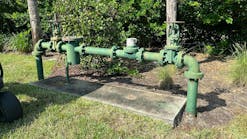Municipalities around the country are increasing their use of catch basin inserts to treat stormwater before it enters surface waters. Part of the increase stems from requirements to meet federal and state regulations and part because it’s the right thing to do. The ability to capture trash, sediment, and pollutants such as oil, grease, and metals increases the quality of the environment for everyone but is especially important for marine habitats.
A multitude of companies are manufacturing products for the catch basin filtration market. Whether your need is for sediment removal, mitigation of pollutants, or trash capture, you can find a product to meet your needs.
Things to consider when buying a system are as follows:
- Initial cost, as well as maintenance and replacement costs
- Type of filtration needed
- Retrofit or new project
- Type of maintenance that will be required
- Space available for filtration devices
Degreasing in Florida
As environmental section supervisor for the National Pollutant Discharge Elimination System in Brevard County, John Royal has a big stake in preventing oil spills from county facilities into waterways. Royal says the county had used a variety of methods to catch hydrocarbon contaminants, including pads and socks. Recently, the county has switched to baskets manufactured by EcoSense International of Merritt Island, FL. The oil filter baskets installed in grated inlets seem to be working well.
Royal notes that the socks and pads that the county had tried in the past were round and floated on the water, so there was limited surface area and contact with the filtering media. The EcoSense filters ensure that water passes through the media, removing a higher percentage of the pollutants.
EcoSense baskets are designed to be nonclogging. Debris such as leaves and other materials are diverted away from the filters. The Clean Pass Over Flow acts as a peak flow bypass but captures lightweight material and allows water through. After first flush, the system catches up and filters the rest of the water. Tests have shown a total suspended solids removal greater than 95%, and hydrocarbons, metals, phosphorus, nitrogen, and volatile organics also are removed.
Filters are cleaned by vacuuming, and because there is no standing water, mosquito and other pest breeding is eliminated. Filter replacement is recommended after six months to two years.
Brevard County is under a municipal separate storm sewer system (MS4) permit, so all county facilities were evaluated for compliance. A list of programs was devised to meet the requirements, including improving the quality of stormwater runoff.
The EcoSense filters were installed at county facilities and many had to be custom built. “We can’t ask the public to control pollutants if we aren’t doing our part,” notes Royal. In the past, the county set up automated samplers to test influent and effluent and found that the filters work well. “They also are cost-effective–fairly reasonable,” Royal adds.
Now the county basically monitors the filters by eye. Of course, if there is a known oil spill from a truck maintenance yard or similar incident, that filter will be changed immediately. For some areas, the runoff is from parking lots, and those filters can have a longer maintenance cycle. In between replacements, loose debris such as leaves and sediment is removed from the filters by vacuum trucks.
EcoSense baskets also were installed to eliminate pollutants going into Wagner Creek and from there to the Miami River. The creek is a test basin for the project. Miami was proactive on this project, not waiting for a total maximum daily load (TMDL) to be developed, says Francis Mitchell, assistant director of public works for Miami-Riverside.
Two hundred and fifty wire baskets with a 25-gallon capacity have been installed as well as 400 grated curb inlets that have been retrofitted. The baskets collect debris and filter stormwater from a highly urban area, with commercial activity and many warehouses. The cost for the baskets and grates was about $200,000, and about five retrofits could be installed by a crew each day.
The maintenance has been performed on a four-month schedule. The retrofits retained 90 pounds of trash (such as bottles and leaves) every four months. So far, they have collected close to 16 tons of trash from 250 retrofits.
To handle the maintenance, Miami bought two mini vacuum trucks, also from EcoSense. In fact, when crews saw how easy the mini trucks were to operate, they were requesting them every day.
The City of Rockledge, FL, has installed EcoSense filters at its maintenance compound. Ken Poole, public works director, says the filters were installed at the breakdown area, so any oil and grease from a vehicle will wash into and be captured by the filters. The town also has added the filters to a washdown area where garbage trucks are washed daily. According to Poole, the filters have worked so well that the washdown area has been expanded to handle two trucks at a time.
After passing through the filters, runoff from the area drains into a large catch basin that holds it so that it can be slowly filtered by the sandy soil. A pipe conduit leads to another dry area, but Poole says he has never seen such an extreme storm that the sandy soil can’t absorb the runoff.
The Rockledge Public Works Department has created a unique way of determining when the filters need to be replaced: It weighs them. Poole says crews use a big fish scale and hook. The filters are attached to the hook, and if the weight is heavy enough, new ones are installed. The department is experimenting to determine the critical weight. The old filters are disposed of with the trash from vehicle maintenance. In the washdown area, filters have been lasting about three months.
The city has developed a proposal for grants to include hydrocarbon filtering for stormwater runoff into the Indian River Lagoon. The requirements mean that the stormwater flow cannot be hampered but must remove a high percentage of hydrocarbons. The drainage area is a 10-acre basin of mostly residential properties. Poole is hoping to find or devise a rectangular filter with a metal framework and hook so he can continue the method of weighing the filter to know when replacement is needed.
Colorado and Washington
King Lloyd, assistant city engineer for Glenwood Springs, CO, designed and built sediment traps for his town. Made of reinforced concrete, they have a 3-foot-diameter storm flow and fit inside a 6-foot-diameter manhole. A segment is cut out down to 14 feet deep, 9 feet deeper than the original line. This provides the capacity to store sediment. Snouts, from Best Management Products Inc. of Lyme, CT, are installed at a 10-inch opening about 2 feet lower than the top level and over the 3-foot outflow.
The Snouts are hooded outlet covers constructed from plastic composites with stainless steel supports. Their design prevents debris, oily residues, and sediment from entering stormwater outflows. Floatables are retained in the chamber, while heavy particles and sediment settle on the bottom. The anti-siphon pipe ensures that only clean water flows into the outflow. Snouts will fit into any sumped structure, and a variety of filters can be added. They will fit round or rectangular pipes.
Snouts come in sizes up to 96 inches. Oil booms can be installed with them in the catch basin. The company also has an odor-control filter that attaches to the anti-siphon pipe inside the chamber. The filter contains a carbon compound that absorbs odors.
For the setup in Glenwood Springs, the effluent flows into a large grassy area where it percolates into the ground. Lloyd says he included the second Snout over the 3-foot line to collect pollutants from a large storm that exceeds the flow through the smaller pipe.
The system collects runoff from 194 acres of mixed-use development. It was installed at the beginning of 2007; after a few storms, the street superintendent checked it. He reports that he found 2-feet of sediment and the aroma of hydrocarbons was strong, so the unit is doing its job.
Maintenance is accomplished with a vacuum truck and so far has been easier than expected.
Lloyd says he is a river runner and wants his area’s rivers to be as clean as possible. Near Glenwood Springs is the junction of the Roaring Fork River and the Colorado River. The Roaring Fork River is a Gold Medal fisheries stream. There are no current federal stormwater requirements for the Roaring Fork, but Lloyd isn’t waiting for those.
In 2003, a consultant suggested an open pond to capture sediments before they entered the Roaring Fork, but Lloyd believes the Snouts were a better solution. “The pond would be more visible to the public and more costly to maintain,” he says. The Snouts were installed and the project was paid for with a grant from the Colorado River Water Conservation District. The cost was $39,000. This summer, Lloyd plans to install catch basin inserts with Snouts during a road reconstruction project.
The City of Federal Way, WA, also has installed Snouts on inlets flowing into Steel Lake. The city’s studies indicate that the devices have been effective in preventing oils, floatables, and other contaminants from entering the lake. Each device is inspected at least once a year.
Connecticut Harbor
Michael Yeosock, senior engineer for the City of Norwalk, CT, says the city has two types of filters operating in the municipality. The area drains into the Norwalk Harbor, which in turn flows into Long Island Sound. It is a completely urban area, with the main runoff coming from streets and both residential and commercial sections.
In November 2005, the city installed 275 Ultra-Urban Filters from AbTech Industries of Scottsdale, AZ. The project was financed by an EPA grant. The installation went well, and the filters were cleaned the first time after six months of operation. Each filter had an average of 54 pounds of trash–15,000 pounds total. “That would have been in the harbor,” Yeosock says.
Maintenance of the filters has gone fairly well. The time required to clean each filter was 10 to 15 minutes, which Yeosock says is acceptable.
The Ultra-Urban Filters are mounted with a galvanized steel bracket for the curb-opening model. The Drain Inlet series has a plastic mounting. The devices handle flow rates from 200 to 500 gallons per minute. Costs are from $250 to $700 per unit.
In January 2007, 40 Cartridge Basins and filters manufactured by the EnviroSafe Division of Transpo Industries were installed around a city park in Norwalk. The Cartridge Basins come in both rectangular and round configurations. Sizes range up to 30 inches by 38 inches and 30-inch-diameter round grates. They have a variety of filtration media, including oil-absorbing foams, antimicrobial applications, and components for heavy metal removal.
Yeosock says the city has been testing influent and effluent for E. coli and oil and gas to determine the efficiency of the filters. So far, he is happy with the quality of sediment removal. If the city can keep sediment from reaching the marina, it will increase the amount of time between dredgings of the harbor. The last dredging cost approximately $250,000, so any extension of time between dredging operations is a big money saver.
The biggest issue is the upfront cost: $800 to $1,000 per filter. But the long-term benefits to the entire stormwater management system need to be considered. Yeosock considers the catch basin insert filters as the most cost-effective solution.
Yeosock reports that the installation of the filters was easy. The contractor installed the first set, using the experience to train public works employees.
Most of the Norwalk area is built out, but any small developments are required to remove oil and grease, so Yeosock expects more of the inserts and filters to be applied in the future.
The Soundkeeper Filter Project is a study of catch basin insert effectiveness at Long Island Sound. The importance of the health of Long Island Sound can be seen in estimates that 10% of the American population lives within 50 miles of the Sound. Soundkeeper Terry Backer and officials from government entities and Connecticut Department of Environmental Protection recently viewed catch basin inserts along the shoreline. The tour group inspected a catch basin insert manufactured by AbTech Industries at the Maritime Aquarium Center. The Smart Sponge used in the device has the capability of absorbing hydrocarbons and has an antimicrobial component. After seeing the food wrappers, debris, oil and grease, and sediment removed by the filters, the officials returned to the capital ready to write bills requiring use of catch basin inserts to protect fragile waterways of Connecticut.
Tests have confirmed that the Smart Sponge insert can absorb up to five times its own weight and removes 75% to 95% of the hydrocarbons present in stormwater runoff. The saturated product does not leach or leak contaminants, so it can be disposed of with solid waste.
California Development
When Lindsy Hubby of Covenant Development, based in Temecula, CA, needed a consultant for catch basin inserts for a project in Victorville, CA, he called Kip Searcy, stormwater management engineer for Katchall. Searcy had been advising the development company on stormwater pollution prevention plans for projects, writing manuals, filing notices of intent, and performing site visits. Katchall Filtration Systems LLC is based in Beaumont, CA.
Katchall catch basin inserts come in both square and round shapes, from 1 foot square to 4 feet by 3 feet and diameters of 2 feet and 3 feet. The filtration media looks like “an old gray flannel shirt,” according to Searcy. The fabric has 27 layers incorporating lots of surface to capture oils, greases, and sediments. Another type of filter has been shown effective in removing bacterial pathogens.
The City of Victorville did not require filtration devices, but a new state water board director said they were needed. Hubby’s project was one of the first developments to file notice of termination with the “new sheriff in town,” as Hubby called the state employee. Hubby was told that stormwater runoff from two roads needed to be filtered before it entered Oro Grande Wash.
“I wish the state and city would play from the same sheet of music,” Hubby notes. He adds that developers often are caught between the state and municipality when there is a disconnect between the expectations of each entity.
Hubby’s company installed the catch basin inserts on two roads that terminate at the wash. Once the developer installed the inserts and the state signed off on the mitigation, the system was handed over to the city. Hubby says the biggest catch (pun intended) will be whether or not the city has the funds or the motivation to maintain the devices.
Other West Coast Filters
When the Burnside Bridge over the Willamette River in Portland, OR, underwent repairs, Multnomah County engineers also fitted the structure with catch basin filters to eliminate runoff pollution. Fourteen CatchBasin StormFilter devices from Stormwater Management (now part of Contech Stormwater Solutions) were installed in the bridge deck. The cartridges filter sediment, oil and grease, metals, and nutrients out of stormwater. Fewer pollutants in the runoff from the bridge mean less pollution in the historic river.
The McKinley Union School District of McKinley, CA, needed a solution to runoff from a bus wash area. It installed a CatchBasin StormFilter to treat the water to the standards required to meet California Phase II limits. The wash water enters the StormFilter through a heavy grate, and heavy particles settle to the bottom of the chamber. The cartridge filters out oils and metals, and then the water is released into a swale and nearby creek.
As these examples show, stormwater experts from around the country are reaching for catch basin inserts and filters to increase the removal of sediment and pollutants. The use of these products is growing rapidly.
In addition to choosing the catch basin inserts and filters most suited to your needs, remember that a critical part of the proper operation of any type of device is maintenance. By setting up routine maintenance plus a plan for emergency replacement in case of a spill, you ensure that the catch basin inserts will fulfill their intended use and protect water bodies for all of us.






